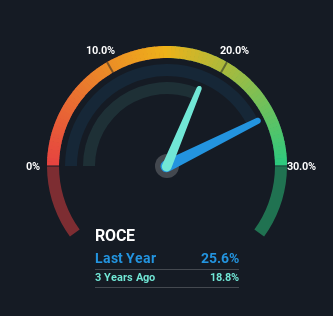Hove (CPH:HOVE) Is Investing Its Capital With Increasing Efficiency

What are the early trends we should look for to identify a stock that could multiply in value over the long term? One common approach is to try and find a company with returns on capital employed (ROCE) that are increasing, in conjunction with a growing amount of capital employed. Basically this means that a company has profitable initiatives that it can continue to reinvest in, which is a trait of a compounding machine. And in light of that, the trends we're seeing at Hove's (CPH:HOVE) look very promising so lets take a look.
What Is Return On Capital Employed (ROCE)?
For those who don't know, ROCE is a measure of a company's yearly pre-tax profit (its return), relative to the capital employed in the business. To calculate this metric for Hove, this is the formula:
Return on Capital Employed = Earnings Before Interest and Tax (EBIT) ÷ (Total Assets - Current Liabilities)
0.26 = kr.22m ÷ (kr.108m - kr.24m) (Based on the trailing twelve months to June 2023).
Therefore, Hove has an ROCE of 26%. That's a fantastic return and not only that, it outpaces the average of 11% earned by companies in a similar industry.
Check out our latest analysis for Hove

Historical performance is a great place to start when researching a stock so above you can see the gauge for Hove's ROCE against it's prior returns. If you're interested in investigating Hove's past further, check out this free graph covering Hove's past earnings, revenue and cash flow.
What Can We Tell From Hove's ROCE Trend?
The trends we've noticed at Hove are quite reassuring. The data shows that returns on capital have increased substantially over the last three years to 26%. The company is effectively making more money per dollar of capital used, and it's worth noting that the amount of capital has increased too, by 151%. This can indicate that there's plenty of opportunities to invest capital internally and at ever higher rates, a combination that's common among multi-baggers.
One more thing to note, Hove has decreased current liabilities to 22% of total assets over this period, which effectively reduces the amount of funding from suppliers or short-term creditors. So this improvement in ROCE has come from the business' underlying economics, which is great to see.
Our Take On Hove's ROCE
To sum it up, Hove has proven it can reinvest in the business and generate higher returns on that capital employed, which is terrific. Investors may not be impressed by the favorable underlying trends yet because over the last year the stock has only returned 5.5% to shareholders. Given that, we'd look further into this stock in case it has more traits that could make it multiply in the long term.
If you want to know some of the risks facing Hove we've found 2 warning signs (1 is concerning!) that you should be aware of before investing here.
If you want to search for more stocks that have been earning high returns, check out this free list of stocks with solid balance sheets that are also earning high returns on equity.
Valuation is complex, but we're here to simplify it.
Discover if Hove might be undervalued or overvalued with our detailed analysis, featuring fair value estimates, potential risks, dividends, insider trades, and its financial condition.
Access Free AnalysisHave feedback on this article? Concerned about the content? Get in touch with us directly. Alternatively, email editorial-team (at) simplywallst.com.
This article by Simply Wall St is general in nature. We provide commentary based on historical data and analyst forecasts only using an unbiased methodology and our articles are not intended to be financial advice. It does not constitute a recommendation to buy or sell any stock, and does not take account of your objectives, or your financial situation. We aim to bring you long-term focused analysis driven by fundamental data. Note that our analysis may not factor in the latest price-sensitive company announcements or qualitative material. Simply Wall St has no position in any stocks mentioned.
About CPSE:HOVE
Hove
Develops, produces, and supplies advanced lubrication solutions for heavy machinery in Denmark and inetrnationally.
Excellent balance sheet low.

